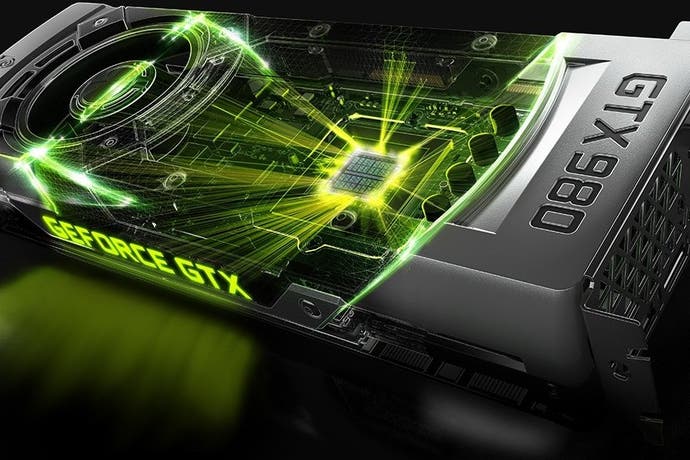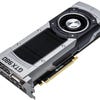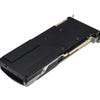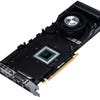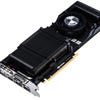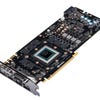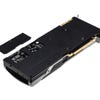Nvidia GeForce GTX 980 review
State of the art.
The King is dead. Long live the King. Nvidia has discontinued its flagship GTX 780 Ti, replacing it with the brand-new GTX 980, powered by its new Maxwell architecture. It's the fastest single-chip graphics card money can buy - but the takeaway for many will be that there's no revelatory performance increase over Nvidia's existing top-end hardware. This is a refined, ultra-power efficient replacement with a relatively small performance bump, as opposed to the next big new thing in graphics technology.
Maxwell's power efficiency shouldn't be so readily discounted though. Performance graphics cards typically consume an absolute maximum of 250W - at full-pelt, that translates into an awfully large amount of heat. Hot chips need cooling, in turn requiring elaborate cooling assemblies, which can produce unwanted noise. The GTX 980's TDP limit is a mere 165W, so the implications here are obvious - the GTX 980 is capable of being deployed in a much larger variety of PCs: living-room small form factor units being the obvious example.
Our review card features the premium metallic chassis introduced with the GTX Titan - clean, industrial, cool and quiet. From an aesthetic standpoint, differences are relatively minor - the PCB backing of the older Nvidia cards has given way to a plastic shroud that more fully encloses the components. A plastic tab on the rear of the unit can be removed in order to facilitate better airflow, but the major differences come on the back-plate: Nvidia's established line-up of dual DVI, HDMI and DisplayPort gives way to a new arrangement: one DVI, one HDMI and three DisplayPorts. The new array of ports has been designed to facilitate easier set-up of surround G-Sync - which still requires DisplayPort to function. Also of interest is that the HDMI port is based on the 2.0 standard, meaning support for 4K resolution at 60Hz.
It's on the inside where the GTX 980 really impresses - its efficiency goes far beyond its meagre power consumption alone. The new Maxwell chip achieves more - a lot more - with a lot less, despite using the same 28nm chip technology as its predecessor. The GM204 chip is around 72 per cent the size of the Titan/GTX 780 Ti processor, and around 91 per cent of the area of the Radeon R9 290X's Hawaii chip. What's more, the new Maxwell card utilises a relatively narrow 256-bit memory bus up against the 384-bit interface of its predecessor and the whopping great 512-bit bus of the R9 290X. Despite this, the GTX 980 powers ahead of both those cards in almost all of the tests we put it through. Put simply - the GTX 980 is cheaper for Nvidia to produce, and while you don't get any pricing benefits as a consumer (the new GTX 970 is Nvidia's value play - we'll review that soon), you do benefit from a much cooler, less expensive card to run.
- Order the GTX 980 4GB from Amazon with free shipping
So what's the secret sauce here? Well, from the GeForce GTX 750 Ti we already know that the Maxwell architecture offers a 2x performance per watt boost compared to Nvidia's last tech, codenamed Kepler. This new, larger chip could almost be considered a Maxwell 2.0 part - it retains all the advantages of its predecessor (a revised approach to its CUDA cores, a big boost to L2 cache) but it also features power-saving features culled from Nvidia's work on the Tegra K1 mobile part found in the Shield tablet. And while the 256-bit memory interface may seem rather narrow for a high-end performance part, lossless compression is utilised on the bus to get higher throughput. It's an interesting approach, but its effectiveness will be limited by the 'compressability' of the material it has to work with - as you'll see later.
But to begin with, let's see how the GTX 980 copes with that most intensive of GPU workouts - the 1080p Crysis 3 gameplay challenge. Here we stack up all settings to the max, turn on v-sync, and utilise SMAA T2X anti-aliasing - the game's best balance between performance and quality. To make things more interesting, we compare the action with two similar playthroughs on the same Core i7 3770K PC running the GTX 780 Ti and the Radeon R9 290X.
This test isn't about maximum frame-rates (v-sync caps that at 60fps), it's about the deviation from the 60Hz update in the most challenging areas. Immediately, we get a sense of this card's potential - there is no 60fps lock as such, but instead the drops are less pronounced than they are on the GTX 980's immediate rivals. It's a good start, but the feeling we're getting is that the card only offers an incremental increase in performance compared to existing high-end parts as opposed to the kind of revelatory leap you might hope for from a new architecture.
Order these alternative top-tier graphics cards with free shipping:
Ploughing on into our benchmark suite, we evaluate the GTX 980 against a range of comparable GPUs, kicking off with the other GTX 'x80' cards Nvidia has released in the last couple of years, along with the products the firm really needs to comprehensively beat - the power-hungry R9 290X and the outgoing GTX 780 Ti. To begin with, we test at 1080p on max settings. Some might consider the GPU tech we're using here as overkill for a meagre 1080p resolution, but the prior Crysis 3 test suggests otherwise. Not only that, but 95 per cent of the PC audience use full HD monitors, according to the Steam hardware survey, so it's a viable test - Nvidia shifts a lot of graphics cards and regardless of power, most of them are utilised on 1080p displays.
We see an average 14 per cent boost over the R9 290X, a mere 5 per cent increase over the GTX 780 Ti and a more handsome 27 per cent uplift compared to the GTX 780. It's the old GTX 680 that provides a like-for-like comparison of the Maxwell vs Kepler generational leap, and here we see the new card lock in a remarkable 61 per cent jump in performance. Both GTX 680 and 980 offer similar levels of power consumption, and both have the 256-bit memory bus.
We've also included overclocking results. Using MSI Afterburner, we ramped out maximum power consumption to 125 per cent of the norm, and achieved a 200MHz boost to the GPU core, and a 475MHz increase to the memory clock. This produces an averaged 12.2 per cent increase in performance at 1080p, perfectly in line with an additional 12 per cent in peak power consumption we measured. Pushing higher on either memory or core clocks produces unwelcome instability, with Metro Last Light's benchmarking run a good proving ground for testing the durability of your overclock.
| 1920x1080 (1080p) | GTX 980 | GTX 980 (OC) | GTX 780 Ti | R9 290X | GTX 780 | GTX 680 |
|---|---|---|---|---|---|---|
| BioShock Infinite, DX11 Ultra DDOF | 121.6 | 130.9 | 116.5 | 93.0 | 99.5 | 79.7 |
| Tomb Raider, Ultimate, FXAA | 91.1 | 104.1 | 90.9 | 85.1 | 71.3 | 56.2 |
| Battlefield 4, Ultra | 87.2 | 98.3 | 78.0 | 70.1 | 65.2 | 50.6 |
| Metro: Last Light, Very High, SSAA | 52.0 | 59.2 | 51.0 | 47.4 | 40.9 | 31.4 |
| Crysis 3, Very High | 77.0 | 86.7 | 71.9 | 68.6 | 60.9 | 50.7 |
At 2560x1440 - or 1440p if you prefer - the narrow memory bus of the GTX 980 starts to make an impact compared to its nearest rivals. Tomb Raider actually runs marginally slower on the new card compared to the GTX 780 Ti, though the 980 still manages to stay comfortably ahead on other titles, especially on Battlefield 4. The massive 512-bit interface of the R9 290X also brings it back into contention, especially on Tomb Raider. Indeed, the 15 per cent average uplift the GTX 980 enjoys at 1080p shrinks to just five per cent at the higher resolution.
Nvidia's new card still manages to comfortably outstrip the non-Ti GTX 780 and once again we are seeing a substantial boost in performance compared to the GTX 980's technological predecessor - the stalwart GTX 680. Memory bandwidth is clearly important at much higher resolutions, and the 256-bit interface on the older card clearly struggles, particularly on the insanely demanding Metro Last Light with its super-sampling preset engaged.
Overall, the benchmarks here suggest that the GTX 980 is a worthy performer at the higher resolution, with our overclock adding a 14.8 per cent boost to the results on average. The combination of Maxwell's refined CUDA core architecture in combination with the compression system in place on the memory bus allows the new card to punch above its weight, but the Tomb Raider result suggests that performance might vary on a game by game basis.
| 2560x1440 (1440p) | GTX 980 | GTX 980 (OC) | GTX 780 Ti | R9 290X | GTX 780 | GTX 680 |
|---|---|---|---|---|---|---|
| BioShock Infinite, DX11 Ultra DDOF | 83.3 | 94.0 | 77.2 | 61.7 | 65.4 | 50.9 |
| Tomb Raider, Ultimate, FXAA | 60.9 | 69.7 | 62.2 | 58.5 | 49.0 | 36.6 |
| Battlefield 4, Ultra | 58.0 | 65.5 | 52.0 | 47.3 | 44.2 | 33.4 |
| Metro: Last Light, Very High, SSAA | 32.6 | 37.9 | 32.2 | 29.7 | 25.8 | 18.8 |
| Crysis 3, Very High | 47.8 | 56.2 | 45.0 | 45.1 | 37.4 | 30.5 |
With 4K monitors now available at the £500 mark (cheaper if you're prepared to stick with a 30Hz refresh), enthusiasts may be wondering how well the GTX 980 holds up when moving up to the ultra-HD standard. Well, the truth is that ideally, you're still looking at two high-end GPUs working parallel to deliver the kind of power required in sustaining 4K on modern games at demanding settings.
For our benchmarks, we drop back the quality presets a single notch - Tomb Raider drops down from ultimate to ultra (TressFX's removal being the major difference), while Battlefield 4's high setting without MSAA is utilised instead of the top-end ultra. It's Metro Last Light that is cut back the most - we drop down from very high to high settings on both overall quality and tessellation, and we turn off super-sampling anti-aliasing (SSAA). Crysis 3 and BioShock Infinite drop to high and ultra respectively. With these settings in place we see that the card is capable of a good experience at 30fps, but in truth, we'd trade that extra resolution for something approaching 60fps at 1440p. Coupled with a 1440p G-Sync monitor, you can get exceptional results here with both the GTX 980 and the outgoing 780 Ti.
Good results on Battlefield 4 and BioShock give the GTX 980 a good 10 per cent average lead over the R9 290X, but in actual fact, it performs worse on both Crysis 3 and Tomb Raider. It's a similar story with the 780 Ti, in fact, but the GTX 980 still manages to comfortably beat the GTX 780 and GTX 680 - but to be honest, neither of those cards should really be considered for 4K gaming on anything other than medium settings at 30fps. With the overclock in place, we actually see our biggest gain in performance at 4K - our cumulative average rises from a 12.2 per cent boost to 14.8 per cent to 17.5 per cent as we move from 1080p to 1440p to 4K.
| 3840x2160 (4K) | GTX 980 | GTX 980 (OC) | GTX 780 Ti | R9 290X | GTX 780 | GTX 680 |
|---|---|---|---|---|---|---|
| BioShock Infinite, DX11 Ultra | 57.4 | 66.8 | 50.7 | 43.7 | 39.9 | 31.8 |
| Tomb Raider, Ultra, FXAA | 39.5 | 45.6 | 43.3 | 40.1 | 34.1 | 26.0 |
| Battlefield 4, High | 46.2 | 53.7 | 41.9 | 38.9 | 35.8 | 26.8 |
| Metro: Last Light, High, AAA | 36.4 | 42.7 | 33.1 | 30.4 | 27.6 | 19.3 |
| Crysis 3, High | 34.2 | 41.9 | 33.4 | 35.2 | 28.1 | 23.5 |
Finally, let's take a look at peak power draw, extracted from the same PC running the Metro Last Light benchmark on each of our tested graphics card. There may be some disappointment at the relatively small increase in performance compared to the GTX 780 Ti in particular, but the power consumption metrics speak for themselves. The GTX 980's peak power draw is a colossal 80W lower than the outgoing 780 Ti, and almost 100W (!) lower than AMD's R9 290X. Even overclocked, it is more energy efficient than the Titan-lite GTX 780 - a stunning result.
Perhaps the most intriguing comparison is with the veteran GTX 680, a board that the new Maxwell offering has much in common with in terms of chip size and the memory bus. We see a seven per cent increase in peak power consumption on the new board in exchange for an average 65 per cent boost in performance.
That's the kind of generational leap we like to see - it's just a bit of a shame that Nvidia didn't really push the boat out and give enthusiasts a real upgrade in terms of performance compared to its existing flagship parts. What if the firm had retained the 384-bit memory interface for GTX 980? What if it had made a chip as large as the GK110 silicon found in the GTX 780, 780 Ti and Titan? A prospective GM210 would have been staggeringly good - perhaps Nvidia is looking to save that particular behemoth for the 20nm fabrication process, allowing for a cooler, quieter product.
| GTX 980 | GTX 980 (OC) | GTX 780 Ti | R9 290X | GTX 780 | GTX 680 | |
|---|---|---|---|---|---|---|
| Peak System Power Draw | 265W | 299W | 345W | 363W | 312W | 248W |
Nvidia is keen to point out that the new range of graphics cards isn't just about the hardware - new features have been added software-side too. One new enhancement is MFAA (multi-frame anti-aliasing), which uses a 2x MSAA base in combination with temporal AA to produce an effect that the company reckons is comparable with 4x MSAA. From a performance standpoint, the hit is said to be the same as standard 2x multi-sampling. The demos we saw at a recent Nvidia tech conference are intriguing, but the technology was not available for testing in the GTX 970/980 launch driver. [UPDATE 19/9/14 8:51am: This Nvidia product video suggests that MFAA can also provide 2x MSAA quality with just a tiny performance hit - skip to around 1:30 for an explanation.]
Since the advent of deferred rendering, MSAA has been on the endangered list. It's no surprise that developers working with console in mind are looking to increase the effectiveness of post-process anti-aliasing, using a similar temporal component to Nvidia's MFAA technology. But cards like the GTX 980 may well have the bandwidth and fill-rate to accommodate MSAA, so we'll be interested to see how good it looks and what the performance hit actually is in demanding titles like Crysis 3 and Watch Dogs.
















What we can test is DSR - dynamic super resolution - a new feature added to Maxwell, which should (hopefully) filter down eventually to existing Nvidia GPUs. Activated via GeForce experience, DSR is targeted at those using 1080p displays, effectively allowing you to access much higher resolutions (up to 4x native resolution), which are then downscaled down to 1080p - super-sampling, effectively. The idea is that if you're running a game with less demanding requirements on the GPU, you can re-deploy the power of the graphics card in order to produce extraordinarily good anti-aliasing.
Nvidia provided some examples in the zoomer gallery above (Assassin's Creed 4, Watch Dogs), but we've added a couple more based on our testing of the technology. If you've got the GPU time to spare, you can achieve some superb results here, but the application on newer titles will be limited - with DSR maxed, you're effectively asking the GPU to render 4K, and as you can see from the performance table above, that's too much of an undertaking for most modern games. However, there is clearly an application worth considering here for less demanding titles like Dark Souls 2 and BioShock Infinite. These titles shipped with post-process anti-aliasing only, and super-sampling makes a big difference.
Nvidia GeForce GTX 980 - the Digital Foundry verdict
Two new GPUs in the new Maxwell line are revealed today - the flagship GTX 980, retailing for £430/€452/$549 and its little brother, the GTX 970 weighing it at a much more competitive £259/€270/$329. The pricing on the top-end card effectively sees it replacing the GTX 780 Ti, which Nvidia is discontinuing. The chances are there will be further ripples down the range - we've yet to test the GTX 970, but based on its spec, its release has obvious pricing ramifications for the GTX 760, 770 and 780, not to mention AMD's line of premium cards from the R9 280X upwards.
In the absence of 20nm graphics chips (Maxwell sits at 28nm - a chip production technology that's now three years old), the arrival of the Maxwell GM204 clearly shakes up the status quo. The GTX 970 and 980 lead the charge, but more cards based on the same chip are set to follow - and the implications for the all-important sub-£200/$300 market are mouthwatering. The GTX 760 is still a good card, but AMD's R9 285 beats it. Better performance with appropriately miserly power draw sounds good to us. Over and above that, Maxwell's stunning efficiency could bring about a revolution in the gaming laptop market - an area which has seen explosive growth in the last couple of years.
But if you're looking for value, perhaps it's the GTX 970 you should be looking at (we're particularly interested in comparing the 970 in SLI vs the 980), along with cut-price sales on existing stocks of Kepler and AMD cards. If you're in the market for a top-end GPU and you come across a heavily discounted GTX 780 Ti, that could well be the smarter choice in the short term while stocks last, assuming you're not interested in Maxwell's enviable power efficiency. The GTX 980 is what it is - an extremely clever piece of technology that's a bit faster than the previous Nvidia flagship, offered at the same price premium but without a commanding increase in raw frame-rates some may have hoped for. In this respect, the card could fall short of enthusiast expectations - at the top-end, the demands of the hardcore almost always put performance first. But for those looking to upgrade from an older card, the combination of power and efficiency Maxwell represents makes it difficult to ignore.
Nvidia debuted its new technology at a recent conference in the USA, which we attended. Nvidia paid for travel and accommodation. The GTX 980 and the other graphics cards featured in this piece were tested at the Digital Foundry office.
